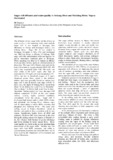Sugar mill effluents and water quality in Imbang River and Malisbog River, Negros Occidental
- Global styles
- MLA
- Vancouver
- Elsevier - Harvard
- APA
- Help

View/
Date
2007Author
Page views
6,550ASFA keyword
AGROVOC keyword
Metadata
Show full item record
Share
Abstract
The effluents of two sugar mills and the effects on water quality in the receiving rivers were studied. Sugar mill A was located in Barangay Dos Hermanas in Talisay and discharged directly into Imbang River. Sugar Mill B was located in Barangay Hawaiian in Silay City and discharged into Malisbog River, a tributary of Imbang. Both sugar mills had sedimentation tanks and lagoons for partial wastewater treatment prior to discharge. Water sampling was done at 13 stations at effluent discharge sites and also upstream and downstream of these sites. The sugar mill effluents were particularly high in biochemical oxygen demand (BOD 109–419 mg/l), total suspended solids (168–384 mg/l), and total solids (1,185–1,234 mg/l), also high in ammonia (0.2–0.5 mg/l) and water temperature (31–38°C), but low in dissolved oxygen (2–5 mg/l). Measured stream flows varied at the different stations and were generally lowest at stations near sugar mill A and at stations near sugar mill B. At these sites, the depth of Imbang River varied from about 10 cm during low water flow in December–May to about 2 m during high water flow in June–November. During normal low flows, the sugar mill effluent comprised 75–85% of the total stream volume, causing highly polluted conditions immediately below the outlets. Sugar mill A discharged high annual loads of solids, BOD, nitrate, and phosphate into Imbang River, whereas sugar mill B loaded plenty of solids, BOD, ammonia, and phosphate into Malisbog River. The sugar cane milling season in Negros Occidental started in October and ended in May, coincident with the dry season. Significantly higher levels of BOD and nutrients, but lower DO, were observed in the river during the milling season (see figures in Gonzales et al., this volume), both because of greater discharge and lower dilution by lower stream flows. River water quality was better at the stations upstream than downstream of the sugar mills. Stations near the sugar mills had BOD, ammonia, and solids at concentrations exceeding the allowable limits set for river water by the Department of Environment and Natural Resources.
Suggested Citation
Gonzales, H. J. (2008). Sugar mill effluents and water quality in Imbang River and Malisbog River, Negros Occidental. In T. U. Bagarinao (Ed.), Research Output of the Fisheries Sector Program (Vol. 2. Reports on Fisheries and Aquaculture, pp. 71-76). Quezon City, Philippines: Bureau of Agricultural Research, Department of Agriculture.
Type
Book chapterISBN
9718511776
Related items
Showing items related by title, author, creator and subject.
-
Seasonal changes and coliform load of Jalaur river, province of Iloilo, Panay island, Philippines
Lantin-Olaguer, Imelda; Pedrajas-Mendoza, Sharon Ann; Pakingking, Rolando V., Jr. ; Yamamoto, Atsushi (Silliman University, 2010)
Determination of the presence/absence of coliforms as the pollution indicator bacteria, total coliform count (TCC) and fecal coliform counts specifically Echerichia coli were carried out on specific sampling points in ...
; Yamamoto, Atsushi (Silliman University, 2010)
Determination of the presence/absence of coliforms as the pollution indicator bacteria, total coliform count (TCC) and fecal coliform counts specifically Echerichia coli were carried out on specific sampling points in ... -
Water quality assessment of the Langat River, Selangor, Malaysia using the natural algal periphyton community and laboratory bioassays of two Chlorella species
Anton, Ann (Aquaculture Department, Southeast Asian Fisheries Development Center, 1990)The physico-chemical conditions in 10 sampling stations off the headwaters of the Langat River, Selangor, Malaysia were studied. Monitoring was done twice a month from June to December 1980. Changes in water quality were ... -
Shrimp pond effluents and water quality in Imbang River, Negros Occidental
Taberna, Evelyn T. (Bureau of Agricultural Research, Department of Agriculture, 2007)The contribution of shrimp farm effluents to the pollution load in Imbang River, Negros Occidental was measured during the period May 1993 to February 1995. Shrimp pond effluents were characterized and the pollution load ...




